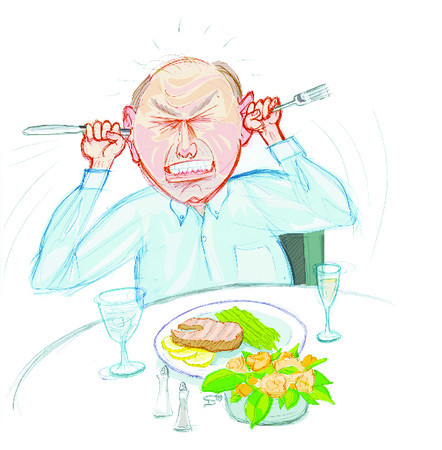Hey, Keep It Down
What did you say? Come again? I'm sorry, but I can't hear you over the clatter in this restaurant.
Back to the page. Ah, much better.
There aren't a lot of things that we as a populace agree on, it seems, but one would probably be that restaurants are getting noisier and noisier.
"There's no excuse for it," said Clark Wolf, a New York-based consultant who has worked with numerous restaurants in Las Vegas.
"They're stupid," he said of restaurant owners. "They're going for easy, quick, fast, high returns."
Jean Hertzman, assistant professor and culinary arts program director for the University of Nevada, Las Vegas, is researching noise levels in restaurants. She attributes the increasing din at least in part to the move away from carpet, draperies and other noise-absorbing materials, including "silencers," which were pads under the tablecloths or part of the tablecloths themselves, "so when you're placing a glass or silverware, it's not as loud. There's not a lot of places that use those anymore. That's part of why some restaurants use two tablecloths."
"Part of it is the casualization of restaurants," Hertzman said of increased noise levels. For example, she said, steakhouses -- ubiquitous at Strip resorts -- "used to be considered fine dining, with traditional design, tablecloths and things like that.
"When they tried to go to a younger, more casual demographic, then the decor's different: open floor patterns, industrial ceilings. That's definitely going to make it noisier."
Another reason, she said, is that many restaurants space their tables closely together, and that many are using open kitchens, so that clatter is added to the clinks and conversation in the dining room.
But what's too loud?
"When the noise distracts you from being able to understand the conversation of the people you are with," she said.
Hertzman said her research has found that people 55 and older tend to express more concern about noise levels, as do people with graduate degrees.
Generally, she said, it's not loud music that gives people the impression that they're eating in a noisy restaurant, but the noise from conversations around them. But Wolf said misuse of music contributes to the problem.
"The proper use of music is to soften the naturally hard sounds," he said. There is a place for ambient noise and music in a restaurant, he added, as a way to engage customers.
"If the sound of the room is dead, it's trouble, too," Wolf said. "Nobody eats in church. But it's supposed to support your evening, not supply it for you.
"The music in a restaurant should be under the conversation, not over it. Otherwise, you've gone to a concert."
Wolf blames the trend at least in part to the fact that "successful club owners got to run restaurants. They're two different businesses. Clubs are designed to burn hot and fast and be gone and over. Restaurants are supposed to be long-term and intimate in different ways. Restaurants are built on trust."
He remembers the restaurants of the '90s, when "the two big things were Sade and the Gipsy Kings, the grilled salmon of music -- safe for everybody." He remembers saying, "If I hear the Gipsy Kings one more time I'm going to blow my head off" -- only to learn that a member of the group was sitting at the bar.
"Music is hard to do," Wolf said. "People want it to be packaged, but it doesn't work that way, which is why it's either done rarely or poorly."
The first job of a restaurant designer, Wolf said, is the use of space. The second, he said, is the relationships between everything in the restaurant, starting with the tables and chairs.
"The lighting is crucial; we've come to understand that," he said. "Sound is just as important; it can be done a lot of different ways. People think you turn up the music and it solves it."
He and Hertzman both said a loud atmosphere can be used in an attempt to turn tables more quickly.
"Loud music is also used like uncomfortable chairs to push turnover," Wolf said. "On purpose, but not admitted."
Hertzman said the restaurant customer faced with a noisy environment has little recourse.
"The only thing they can really do is ask if there's a quieter area they can move to," she said, "if it's an area where the tables are too close or too close to the kitchen."
The final solution is to vote with your feet.
"I would definitely advise people to let management know on their way out or take advantage of the comment cards if they have them," she said. "Otherwise, the restaurants are never going to know if people think it's a problem."
Contact reporter Heidi Knapp Rinella at hrinella@reviewjournal.com or 702-383-0474.

















